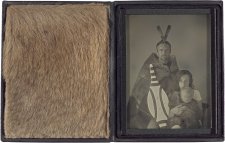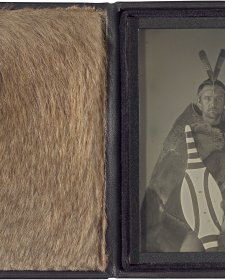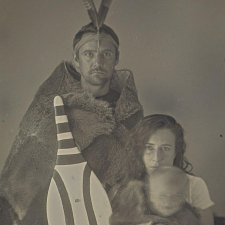- About us
- Support the Gallery
- Venue hire
- Publications
- Research library
- Organisation chart
- Employment
- Contact us
- Make a booking
- Onsite programs
- Online programs
- School visit information
- Learning resources
- Little Darlings
- Professional learning
Marie Carandini (née Burgess, 1826–1894), aka 'Madame Carandini', was seven years old when her family arrived in Van Diemen's Land as assisted immigrants. Aged seventeen, in Hobart, she married Jerome Carandini, tenth Marquis of Sarzano, an Italian political exile 23 years her senior, who'd come to Van Diemen's Land as a member of a travelling musical troupe. Having had some tuition in singing from John and Elizabeth Bushelle, Marie made her debut in a 'musical melange' at the Royal Victoria Theatre in Hobart in August 1843. One newspaper reported that 'her singing was of a most superior order', and another opined that 'under able tuition, a voice of such compass, uniting with its strength such flexibility and sweetness, could be raised to a high standard of appreciation.' In August 1844, following the birth of their first child, Rosina, the Carandinis relocated to Sydney, where Marie continued her training under musician Isaac Nathan, the English contralto Sara Flower, and again with the now-widowed Madame Bushelle. She made her Sydney debut in February 1845; reviews of performances in June the same year stated that her voice 'is not yet highly cultivated, but she has much taste and will always be heard with pleasure.' By 1855, she was being compared favourably to the Irish-born prima donna Catherine Hayes, the Age reporting of her performance in Bellini's La Sonnambula at Melbourne's Theatre Royal in October 1855 that 'there was a tacit expression of regret that the lyric stage should have so long remained without such a valuable acquisition to its corps.' Marie then performed alongside Hayes in Lucia di Lammermoor, Norma, The Bohemian Girl and Lucrezia Borgia. Following Hayes' return to Europe in 1856, Carandini emerged as foremost among Australian opera singers. In 1859, she was among the performers headlining the festival to inaugurate the Great Hall at the University of Sydney, and later the same year she returned to Melbourne for a season of opera at the Royal under Gustavus Vaughan Brooke.
Around 1860, with her daughters Rosina (1844–1932), Fannie (1849–1904), and Isabella (1851–1934), she formed her own company – the Carandini Family Troupe – which toured the colonies throughout the 1860s and 1870s and which also travelled to India, Hawaii, California and New Zealand. Her youngest daughters, Elizabeth and Marie, were born in Tasmania in 1854 and 1863 respectively. Marie continued to perform following Jerome Carandini's death in 1870, making her farewell appearances in Melbourne and Adelaide in 1892. In retirement she lived with Fannie near Bath, England, where she died in 1894. 'Her beautiful voice, her finished style, and that sympathetic quality which always put her in touch with her audience, rendered Madame Carandini a most popular favourite throughout Australia', stated her obituary in the Adelaide Advertiser.
Purchased 2022
Charles Hewitt (age 35 in 1872)
A Marion Son and Co (Paris/London)
Madame Marie Carandini (age 46 in 1872)



On one level The Companion talks about the most famous and frontline Australians, but on another it tells us about ourselves.



This sample of 56 photographs takes in some of the smallest photographs we own and some of the largest, some of the earliest and some of the most recent, as well as multiple photographic processes from daguerreotypes to digital media.



Visit us, learn with us, support us or work with us! Here’s a range of information about planning your visit, our history and more!